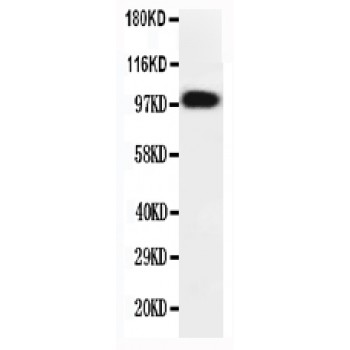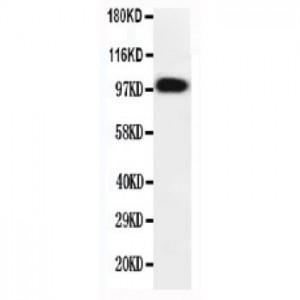More info
Overview
Long Name | Antibody Type | Antibody Isotype | Host | Species Reactivity | Validated Applications | Purification |
| fibroblast growth factor receptor 2 | Polyclonal | IgG | Rabbit | Human, Mouse, Rat | WB | Immunogen affinity purified. |
Immunogen | ||||||
| A synthetic peptide corresponding to a sequence at the N-terminus of human FGFR2(90-109aa EYLQIKGATPRDSGLYACTA), identical to the related mouse and rat sequences. | ||||||
Properties
Form | Lyophilized |
Size | 100 µg/vial |
Contents | Antibody is lyophilized with 5 mg BSA, 0.9 mg NaCl, 0.2 mg Na2HPO4, 0.05 mg Thimerosal and 0.05 mg NaN3. *carrier free antibody available upon request. |
Concentration | Reconstitute with 0.2 mL sterile dH2O (500 µg/ml final concentration). |
Storage | At -20 °C for 12 months, as supplied. Store reconstituted antibody at 2-8 °C for one month. For long-term storage, aliquot and store at -20 °C. Avoid repeated freezing and thawing. |
Additional Information Regarding the Antigen
Gene | FGFR2 |
Protein | Fibroblast growth factor receptor 2(FGFR-2) |
Uniprot ID | P21802 |
Function | Tyrosine-protein kinase that acts as cell-surface receptor for fibroblast growth factors and plays an essential role in the regulation of cell proliferation, differentiation, migration and apoptosis, and in the regulation of embryonic development. Required for normal embryonic patterning, trophoblast function, limb bud development, lung morphogenesis, osteogenesis and skin development. Plays an essential role in the regulation of osteoblast differentiation, proliferation and apoptosis, and is required for normal skeleton development. Promotes cell proliferation in keratinocytes and immature osteoblasts, but promotes apoptosis in differentiated osteoblasts. Phosphorylates PLCG1, FRS2 and PAK4. Ligand binding leads to the activation of several signaling cascades. Activation of PLCG1 leads to the production of the cellular signaling molecules diacylglycerol and inositol 1,4,5-trisphosphate. Phosphorylation of FRS2 triggers recruitment of GRB2, GAB1, PIK3R1 and SOS1, and mediates activation of RAS, MAPK1/ERK2, MAPK3/ERK1 and the MAP kinase signaling pathway, as well as of the AKT1 signaling pathway. FGFR2 signaling is down-regulated by ubiquitination, internalization and degradation. Mutations that lead to constitutive kinase activation or impair normal FGFR2 maturation, internalization and degradation lead to aberrant signaling. Over-expressed FGFR2 promotes activation of STAT1. |
Tissue Specificity | |
Sub-cellular localization | Cell membrane; Single-pass type I membrane protein. Golgi apparatus. Cytoplasmic vesicle. Note: Detected on osteoblast plasma membrane lipid rafts. After ligand binding, the activated receptor is rapidly internalized and degraded. |
Sequence Similarities | Belongs to the protein kinase superfamily. Tyr protein kinase family. Fibroblast growth factor receptor subfamily. |
Aliases | bacteria-expressed kinase antibody|BBDS antibody|BEK antibody|BEK fibroblast growth factor receptor antibody|BFR1 antibody|CD332 antibody|CD332 antigen antibody|CEK3 antibody|CFD1 antibody|Craniofacial dysostosis 1 antibody|ECT1 antibody|FGF receptor antibody|FGFR 2 antibody|FGFR-2 antibody|Fgfr2 antibody|FGFR2_HUMAN antibody|Fibroblast growth factor receptor 2 antibody|Hydroxyaryl protein kinase antibody|Jackson Weiss syndrome antibody|JWS antibody|K SAM antibody|K-sam antibody|Keratinocyte growth factor receptor 2 antibody|Keratinocyte growth factor receptor antibody|KGFR antibody|KSAM antibody|protein tyrosine kinase, receptor like 14 antibody|soluble FGFR4 variant 4 antibody|TK14 antibody|TK25 antibody |
Application Details
| Application | Concentration* | Species | Validated Using** |
| Western blot | 0.1-0.5μg/ml | Human, Rat Mouse | AssaySolutio's ECL kit |
AssaySolution recommends Rabbit Chemiluminescent WB Detection Kit (AKIT001B) for Western blot. *Blocking peptide can be purchased at $65. Contact us for more information

Anti-FGFR2 antibody, ASA-B0707, All Western blotting
All lanes: Anti-FGFR2(ASA-B0707) at 0.5ug/ml
Lane 1: HELA Whole Cell Lysate at 40ug
Predicted bind size: 92KD
Observed bind size: 98KD
All lanes: Anti-FGFR2(ASA-B0707) at 0.5ug/ml
Lane 1: HELA Whole Cell Lysate at 40ug
Predicted bind size: 92KD
Observed bind size: 98KD



